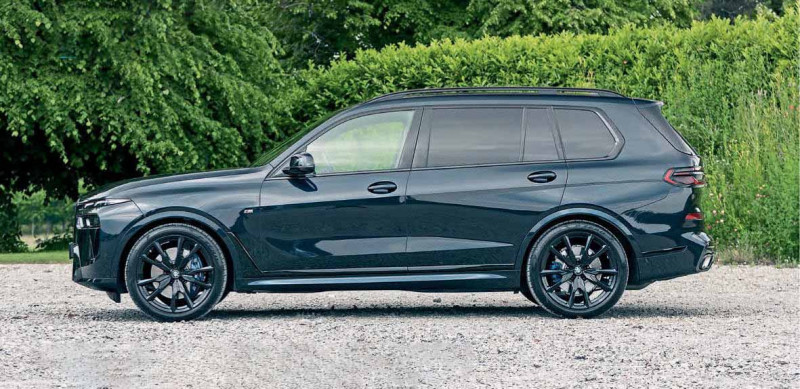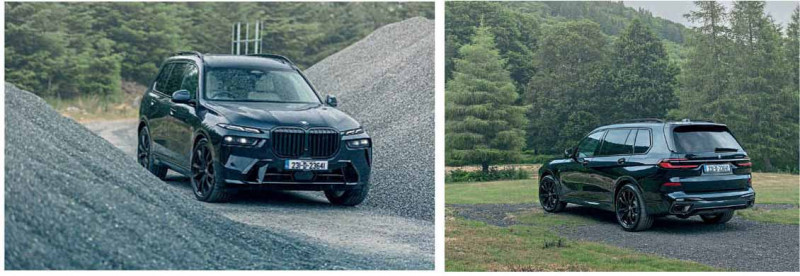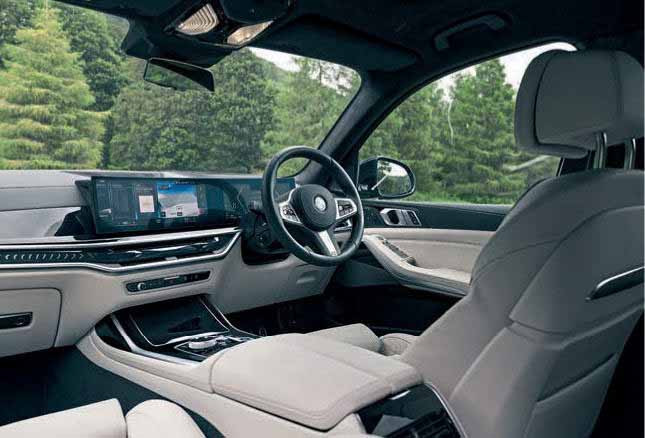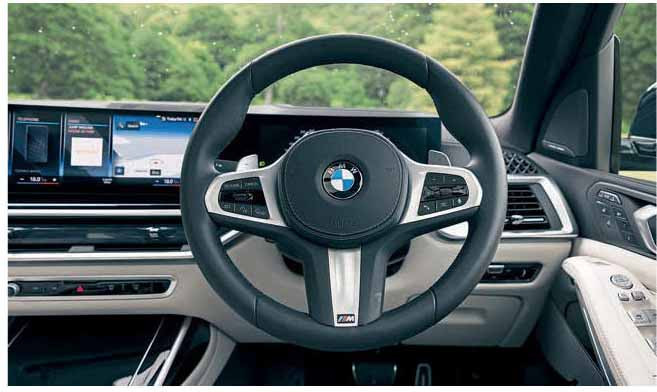2024 BMW X7 xDrive40d G07 LCI
When size matters, does any other BMW compare with the mighty X7 SUV? And for long-distance comfort and performance, there’s the excellent xDrive40d version.
Words: Neil Briscoe
Photos: Paddy McGrath
First Drive: G07 LCI X7 xDrive40d
Still big and better than ever, we get behind the wheel of the facelifted X7.
If size truly, really matters, then surely the X7 is the greatest BMW of them all? We mean, clearly, the lower, lighter stuff still has its place – E30 M3, M1, M2 and so on – but if we’re talking about getting the maximum possible amount of BMW for your money is what matters, then the X7 beats them all.

You can leave at the door any concerns that the X7 is too big or too heavy to count itself a ‘proper’ BMW – the original X5 blew any such concerns straight out of the water more than 20 years ago. While the X7 is certainly bigger and heavier – arguably too much so for UK roads – it, too, has the qualities of a genuine Munich machine.
The version we’re testing here is the X7 xDrive40d M Sport. That means it uses the familiar B57 2993cc inline six-cylinder diesel engine with two-stage turbocharging. In this setup, the X7 xDrive40d produces up to 352hp and a hefty 531lb ft of torque – sufficient to allow for a 5.9-second 0-62mph sprint, which is more than impressive for a machine weighing 2565kg at the kerb.

While a plain old diesel engine might seem a touch out of step with a world heading rapidly towards an electric future, the X7 xDrive40d does benefit from at least a touch of electric power thanks to a 48-volt mild-hybrid system. That adds a compact lithium-ion battery, which is charged up by coasting and braking, and a crankshaft-mounted starter-generator, which keeps the engine switched off for longer when you’re crawling along in heavy traffic and allows a little bit of engine-off ‘sailing’ when you’re cruising on the motorway. It can also chime in with a power and torque boost – an extra 9hp and 200Nm of torque at times when you push your right foot right down.

There is clearly an efficiency boost, thanks to the mild-hybrid setup. While it would be daft to claim that this tall, bulky, luxurious X7 is an economy model, it can be surprisingly economical. BMW quotes WLTP fuel economy of 36.2mpg, and that’s pretty easy to achieve in everyday driving. Better yet, if you drive it gently, the engine rises to the challenge, and we saw an indicated 44.1mpg on one easy-going motorway run. You should easily put 600 miles between refills of the 80-litre fuel tank.
Combine that with BMW’s assertion that the factory in which the X7 is built – the vast Spartanburg plant in South Carolina, USA – now runs on sustainable energy and that the X7 has an increasing amount of recycled material in its makeup (not to mention vegan ‘leather’ options) and maybe it’s not quite the planet-destroying behemoth that it first appears to be.

That may be something of a side concern, of course, at least for most owners. While you can buy all of the X7 models in the UK – including the 40i straight-six petrol and the M60i V8 – the fact is that this is a car more aptly designed for the US and Asian markets, where space, tax and fuel costs are less of an issue. Is styling also less of an issue? It’s often said that BMW’s move away from its more traditional styling cues towards big, expressive styling such as that seen here, has been done mostly for Asian markets, especially China, where brasher styling seems to go down better. The X7 has always had slightly controversial looks, but for what it’s worth, we think that this updated car, with the i7-style split LED lights and the new grilles (which optionally light up at night), looks a touch sleeker and more attractive than the previous version. The lights at the rear are also new, as are the optional 23” alloy wheels.
Once you step inside, you’ll soon forget any quibbles about the exterior styling. Befitting a car with a 7 in its name, the cabin of this big SUV is genuinely luxurious. Now, it doesn’t quite hit the heights of design and comfort that you’ll find in the likes of the i7 or XM, but it is still enormously impressive.
The biggest change on the inside for this LCI facelift model is that it now gets the twin digital screen layout which has been rolled out to almost all models in the range, using the eighth-generation iDrive software. That means that the whole dashboard has changed, really. The overall shape of the cabin is still the same, but you now get the conjoined 14.9” infotainment screen and 12.3” driver’s instrument display (backed up by a very impressive head-up display). Below the big screen is a new set of slimline air vents, with the little ‘joystick’ adjuster as seen in the i7 and 7 Series, while the panel in which those vents sit is now backlit, complete with an X7 logo in front of the front passenger. Up above, there’s a standard three-section panoramic roof, which on our test car came with the optional Sky Lounge system, which uses LEDs embedded in the glass to shine a variety of patterns, imitating a starry night, even if the real sky is overcast.
Down on the centre console, many of the switches and buttons will be familiar from other, lesser BMWs, but they are – as with the steering wheel – none the worse for that. The chunky gear shifter of the first X7 has gone, replaced with a neat little toggle switch gear selector which you can optionally have in a crystal-effect finish. In front of that is a pair of cupholders, which are slightly small but are at least chilled and heated as you require. While the new gen-8.0 iDrive is generally very impressive, we have to say that we preferred the older digital layout of the X7 (and various other BMW models). We just find that the graphics look a little cheesy in the new layout, and the moving of all of the climate controls, bar a max defrost and rear de-mist pair of physical buttons, to the screen is just too fiddly and annoying at times. Simplicity still has a place, even in highly luxurious interiors such as this. At least the front seats make up for that. They don’t feel quite so sofa-like as those in the i7, but they’re still hugely comfortable and supportive, and in our test car, they’re both heated and ventilated.
In the middle row of seats – the X7, as per its name, comes as standard with seven seats – things are a little more mixed. The rear seats adjust back and forth and recline electrically, which is nice and when you have them fully back, there’s sufficient legroom for the rear to live up to the X7’s luxury billing. However, when they’re moved forward, such as to make space for those in row three, legroom disappears pretty quickly, and the X7’s rear seat can suddenly start to feel a touch short on space.
That’s true in row three, too. Headroom in the entire cabin is excellent, but knee and foot space is at a premium, so despite the X7’s generous exterior dimensions, these extra seats really are aimed more at kids than adults. You can, optionally, dispense with the centre rear seat altogether and instead have a more luxurious club-class two-seat centre row.
At least the boot is excellent. Fold down the third row of seats (which is done electrically, using buttons either in the boot area or just inside the back doors), and you’ve got a massive 750 litres. Fold down row two, and there’s a huge 2120 litres of available space. Even with all the seats in use, there’s still a fairly useful 326 litres of space on offer, so you won’t have to have all of your luggage sent on ahead… Because the X7 comes with standard adaptive air suspension, there’s another button in the boot which can lower the rear, squatting the back down to make it easier to load heavy items. The tailgate is split, which is handy in tight car parks, and the lower half of which also gives you a handy perch on which to sit for picnics. All of this luxury and space is all well and good, but what is the X7 actually like to drive? If, after all, it’s going to be treated as a proper, true BMW, then it ought to drive like one, right?
The news on that score is mostly good but with one caveat. We’ll get to that in a moment, but the first thing you notice about the X7 just how quiet and refined it is. Even with a diesel engine providing the power, and even with electric cars available for comparison, the X7 glides along in near-perfect silence (which you can easily break with the brilliant standard-fit Harman Kardon stereo).
The adaptive air suspension plays a big part in all of this. The air springs work with double-wishbones up front and a five-link rear axle, and the comfort levels are exceptional. This is one of those rare air suspension setups which doesn’t seem fazed by short, sharp bumps around town – indeed, the X7 seems to have the beating of its great rival, the Range Rover, in this regard. You can adjust the ride height by as much as 80mm, using a little toggle switch on the centre console, but this is arguably of more use dropping the X7 down to make it easier to get in and out than trying to challenge any local offroading clubs to a quick mud-plugging challenge.
The xDrive four-wheel-drive system is, for the X7, biased slightly more towards the rear wheels than the fronts, although it can, of course, direct power to whichever end can use it better. Does it feel like a traditional rear-wheel-drive BMW because of that? Almost – there is a sense in which the rear feels slightly more like it’s pushing than the front is pulling, but to be honest, you’d have to be pushing hard and cornering with enthusiasm to detect much of that, which is surely not how the X7 likes to be driven. Activate Sport mode, and the X7 xDrive40d does tighten and tauten up – you can feel the extra weight through the steering, sense the extra responsiveness from the engine and hear the extra piped sounds coming through the stereo, which try to momentarily convince you that your straight-six is actually a V8.
To be honest, we’re not sure you’d actually want a V8 over this engine. With all that torque, the X7 is indecently brisk off the line for something this big, and that claimed 5.9-second 0-62mph time feels entirely realistic. It doesn’t quite have the instantaneous response of an electric motor, of course, but wait a beat or two for the turbos to take a big huff of air, and the X7 just flies along, with that crisp, creamy six-pot growl goading you on. There is that caveat hanging in the air, though. Its weight. That 2.5-tonne kerb weight puts a physics roadblock in the X7’s path that no amount of air suspension nor clever electronics can dance around. In Sport mode, the steering has terrific initial response, and that big, shark-like nose starts to dive towards the apex of the corner you’re driving at. However, before you get there, the X7 suddenly remembers that it’s a big, tall, multitonne SUV and that heft starts to push the nose wider and wider. You can try harder, try hustling the steering with big inputs from your shoulders, but the net effect is the same. So the X7 does drive like a true BMW, but only up to a point, after which its bulk starts to overwhelm proceedings.
This is a bit of a shame, but then that’s not really how you drive cars such as this. That’s the job of an M2 or a 128ti. The X7’s job is to transport as many as seven people across great distances, in maximum comfort and refinement. That it does, and for that, it frankly deserves some kind of blue riband, so good is the X7 at such tasks.
So, yes, size does matter. Because it’s through its size that the X7 can give you so much comfort and quietness. The ultimate driving machine? Not quite. The ultimate cruising machine? Just maybe…
Standard-fit LED headlights; M Sport models come equipped with blue calipers.
The interior feels extremely luxurious, as you’d expect; rear legroom varies depending on the seat position; the boot offers plenty of space, even with the third row of seats up.
DATA FILE 2024 BMW X7 xDrive40d G07 LCI
- ENGINE: 3.0-litre twin-turbo diesel straight-six
- TRANSMISSION: ZF 8HP Steptronic eight-speed automatic gearbox
- MAX POWER: 352hp @ 4400rpm
- MAX TORQUE: 531lb ft @ 1750-2250rpm
- 0-62MPH: 5.9 seconds
- TOP SPEED: 152mph
- ECONOMY: 36.2mpg
- CO2 EMISSIONS: 205g/km
- PRICE: £89,405


